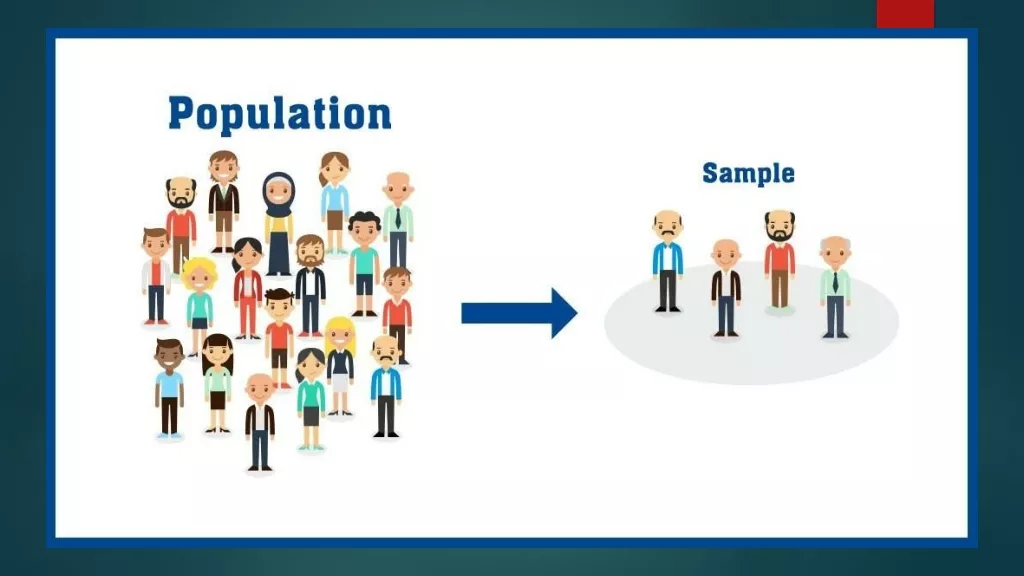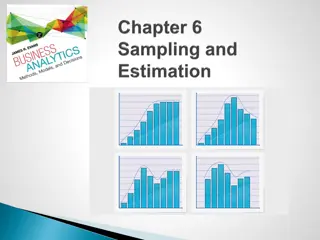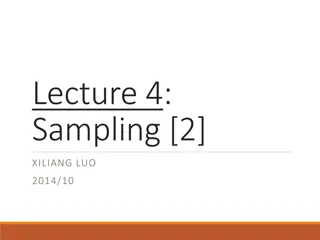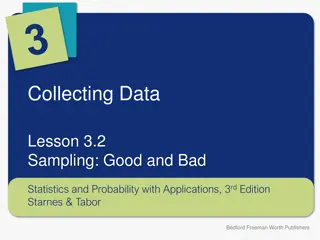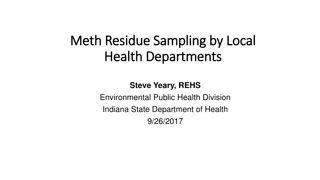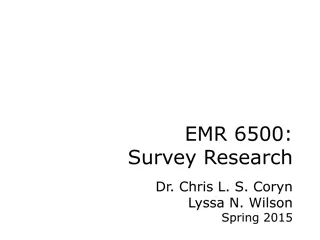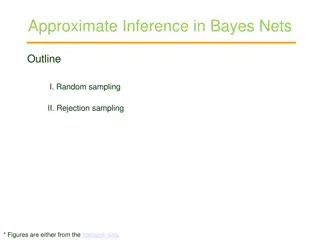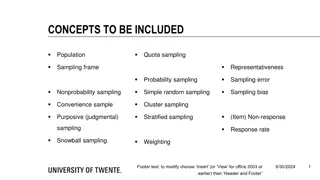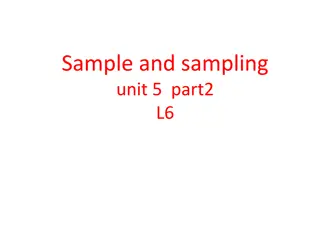
Understanding Sampling Methods for Research Studies
Discover the importance of sampling in research studies, including the characteristics of a good sample and the types of sampling methods like probability and non-probability sampling. Explore simple random sampling and its execution through methods like the lottery method and the use of random number tables.
Download Presentation

Please find below an Image/Link to download the presentation.
The content on the website is provided AS IS for your information and personal use only. It may not be sold, licensed, or shared on other websites without obtaining consent from the author. If you encounter any issues during the download, it is possible that the publisher has removed the file from their server.
You are allowed to download the files provided on this website for personal or commercial use, subject to the condition that they are used lawfully. All files are the property of their respective owners.
The content on the website is provided AS IS for your information and personal use only. It may not be sold, licensed, or shared on other websites without obtaining consent from the author.
E N D
Presentation Transcript
Sampling A sample is a smaller representation of a large whole (Goodie and Hatt) A small part of the whole universe is studies and inference is drawn Through sampling, we get our desired information with minimum cost Census Method: It refers to the complete record of a universe, e.g. population census
Characteristics of a good sample 1. A sample must be a true representative of the universe. It should contain majority characteristics of the population/universe 2. It should be free from biasness. The researcher interest and his/her likes/dislikes should not influence the sample 3. It should be adequate in size to be able to reflect the characteristics of the whole universe 4. It should be viable in the contest of fund available for the research study 5. It should be such that the results of the sample study can be generalized for the whole universe
Types of Sampling 1. Probability Sampling 2. Non-Probability Sampling Probability Sampling is one where each unit has the same and equal chance of being selected whereas in non-probability sampling, the sample is not based on chance. It depends upon the discretion or judgment of the researcher.
Types of Probability Sampling 1. Simple Random Sampling 2. Systemic/Regular Interval Sampling 3. Stratified Random Sampling 4. Cluster Sampling
Types of Non-Probability Sampling 1. Convenience or accidental sampling 2. Purposive Sampling 3. Snow ball sampling
Simple Random Sampling It is the most commonly used and most familiar method of probability sample In this method, each member of the population has an equal probability of being included in the sample The selection of units is carried out by two methods: Lottery Method 1. Use of random number table 1.
Lottery Method Each unit of population is assign a number They are written in a slip, ticket, or token They are put in a container and mixed together Units are selected unless the sample size is achieved Usually, the units selected are not put back into the container Use of Random Number Table Assign a number to each unit of population Random number table can be used across columns or across rows For example, If the sample size is 100, select any three columns or rows,
Merits of Simple Random Sample More scientific method of selecting respondents Less chances of error Representative sample can be drawn easily Less chances of researchers biasness Demerits of Simple Random Sample It can be applied only on small population Difficult to applied on heterogeneous population Widely disperse population is collected
Systematic/Regular Interval Sampling In this method, sample is selected through proper way Draw a sample interval Select a random number Every Z number become the sample Example: Total Population = Sample Size = n = 250 Sample Interval = Select a random number from sample interval, i.e. from 1 20, lets say its 12 So the first respondent is 12, and every 20threspondent is the sample Z r N = 5000 (N/n = Z ) Z = 5000/250 = 20
Merits of Systematic/Regular Interval Sample More scientific approach Saves time, money and energy Provide a more representative sample Easy to work out Less chances of researcher s biasness Demerits of Systematic/Regular Interval Sample It can only be applicable on small population Difficult to apply on heterogeneous population
Stratified Random Sampling It is also commonly known as the proportional stratified sampling technique Stratified sampling is used where population is heterogeneous In this method, the universe is divided into sub-groups based on some factor Stratification can be made on the basis of geographical area, age groups, gender etc. A separate sample is drawn from each sub-group For example, in a company, there are the following staff Strata 1 = Male (Full Time) = 90 Strata 2 = Male (Part Time) = 18 Strata 3 =Female (Full Time) = 9 Strata 4 =Female (Part Time) = 6 Total 180
We are asked to take a proportional sample of 40 staff Strata 1 = Strata population x Sample size / Total Population: Strata 1 = 90 x 40/180 = 20 Strata 2 = 18 x 40/180 = 4 Strata 3 = 9 x 40/180 = 2 Strata 4 = 63 x 40/180= 14 Total = 40
Other Examples If you are interested to see the internet usage, you can stratify by age groups or by gender for example If you are interested to see smoking habits, you can stratified by gender or by social class If you are interested to discuss the standard of high education, stratification can be made on the basis of gender (male female) or by profession such as students, teachers, admin staff
Merits of Stratified Sampling By stratification, a heterogeneous population can easily be divided into homogeneous population Representative sample can easily be drawn It is more convenient Demerits of Stratified Sampling It is time consuming Require technical skills in stratification Improper stratification may lead to bias in sampling
Cluster Sampling In cluster sampling, the universe is divided into sub- groups or clusters and a random sample of these clusters are selected. All observations in the selected clusters are included in the sample These clusters may be geographical area, work-groups, schools, universities etc. After the cluster has been formed, a sample is drawn from among the total group of clusters by using any other method of sampling For example, if you are interested to study the impact of floods on the people, you may divide the total population into different clusters and choose one of them for study purpose
Merits of Cluster Sampling More economical than other methods Easy to calculate Easy to accumulate large population Demerits of Cluster Sampling There are more chances of biasness in the selection of clusters to be studied Its representativeness is doubtful Its finding cannot be applied on the whole population
Non-Probability Sampling Convenience or accidental sampling It is based on the convenience of the researcher Respondents that are easily available to the researcher are interviewed For example, if a researcher is interested to interview 50 people, so the first 50 people he meets become his respondents
Purposive Sampling This is also known as the expert choice sampling In this method, sample are drawn in order to meet some predetermined criteria The researcher has familiarity with the situation and select respondents accordingly
Judgment Sampling In this method, the researcher use his own judgment in the selection of respondents The researcher decides as to who can best satisfy the needs of his research and he interviews them Snowball Sampling In this method, the first respondent is located and researcher ask respondents go give referral to other possible respondents.
Snowball Sampling Technique It is also known as the Chain Sampling, Chain-referral sampling or referral sampling It is a type of non-probability sampling technique This method is used when target population are difficult to locate Data is collected from few members of the target population that the researcher can locate Other members are located with the help of the known respondents This method is mostly used in exploratory studies For example, this method can best be used to study the problems of homeless people, the illegal immigrants, disability, divorce etc.
Merits & Demerits of Snowball Sampling Merits Hidden population can easily be located It is cost efficient and saves researcher s time because researcher don t have search for another respondent, he is referred to another respondent Demerits Researcher and community biasness. The first participants will have strong impact on the sample Representative sample cannot be collected to no information about total population Generalization is difficult

